NMIH108 Health Behaviour Change: Reducing Meat Consumption Report
VerifiedAdded on 2023/06/07
|16
|4289
|193
Report
AI Summary
This report documents a student's attempt to modify their health behavior by reducing meat consumption by 30% over a period of weeks. The baseline behavior, health behavior goal, and action plan are clearly defined, including strategies like substituting meat with grains during lunch and seeking peer accountability. The report identifies potential barriers such as taste, price, convenience, and television advertising, as well as enablers like the desire to improve overall health, lose weight, and enhance body image. Rewards for achieving short-term goals are also outlined. A weekly health behavior change diary tracks progress, noting both successes and setbacks, and adjustments made to the plan. The student reflects on the challenges and motivational factors involved in changing dietary habits, providing insights into the complexities of health behavior change.
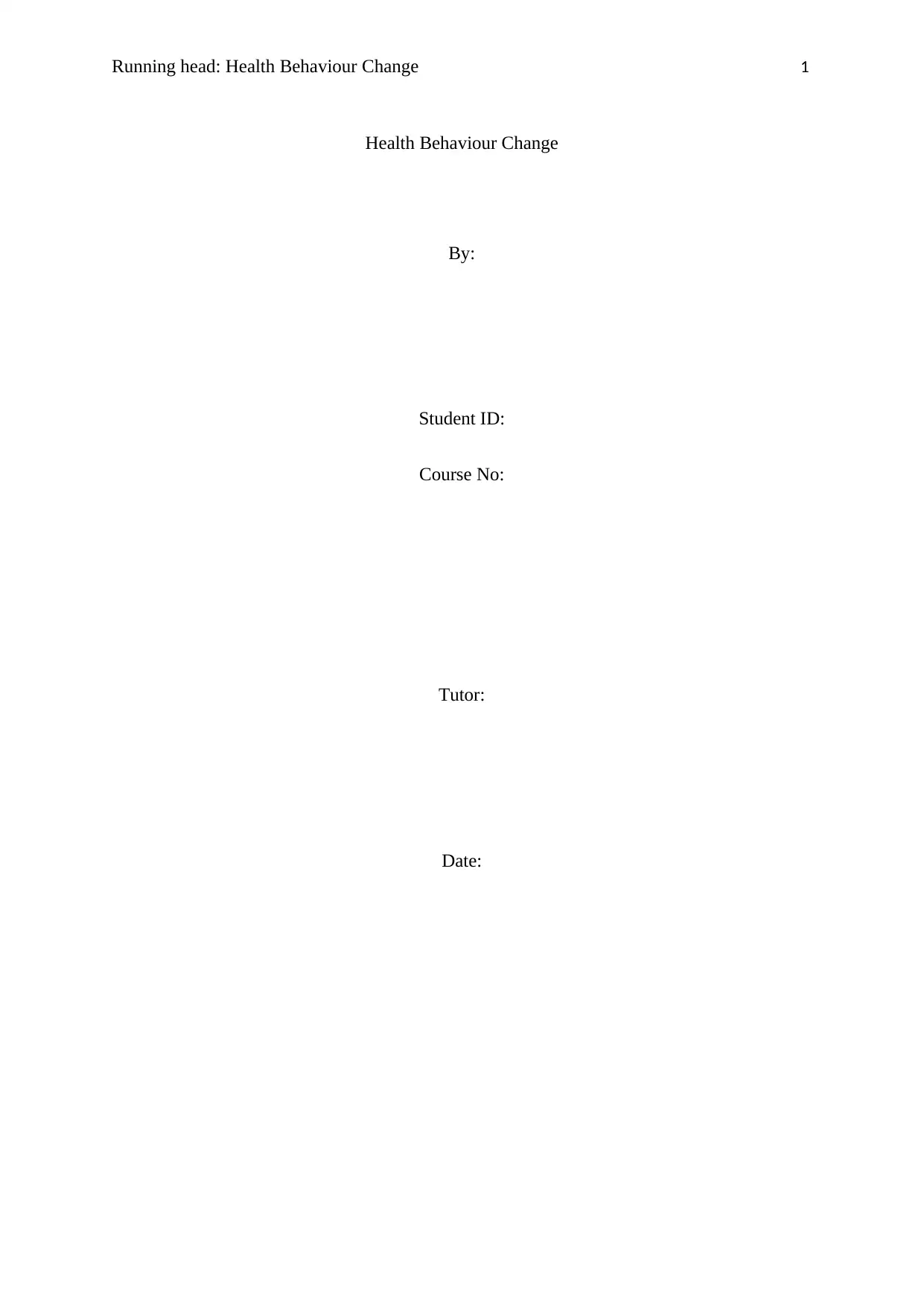
Running head: Health Behaviour Change 1
Health Behaviour Change
By:
Student ID:
Course No:
Tutor:
Date:
Health Behaviour Change
By:
Student ID:
Course No:
Tutor:
Date:
Paraphrase This Document
Need a fresh take? Get an instant paraphrase of this document with our AI Paraphraser
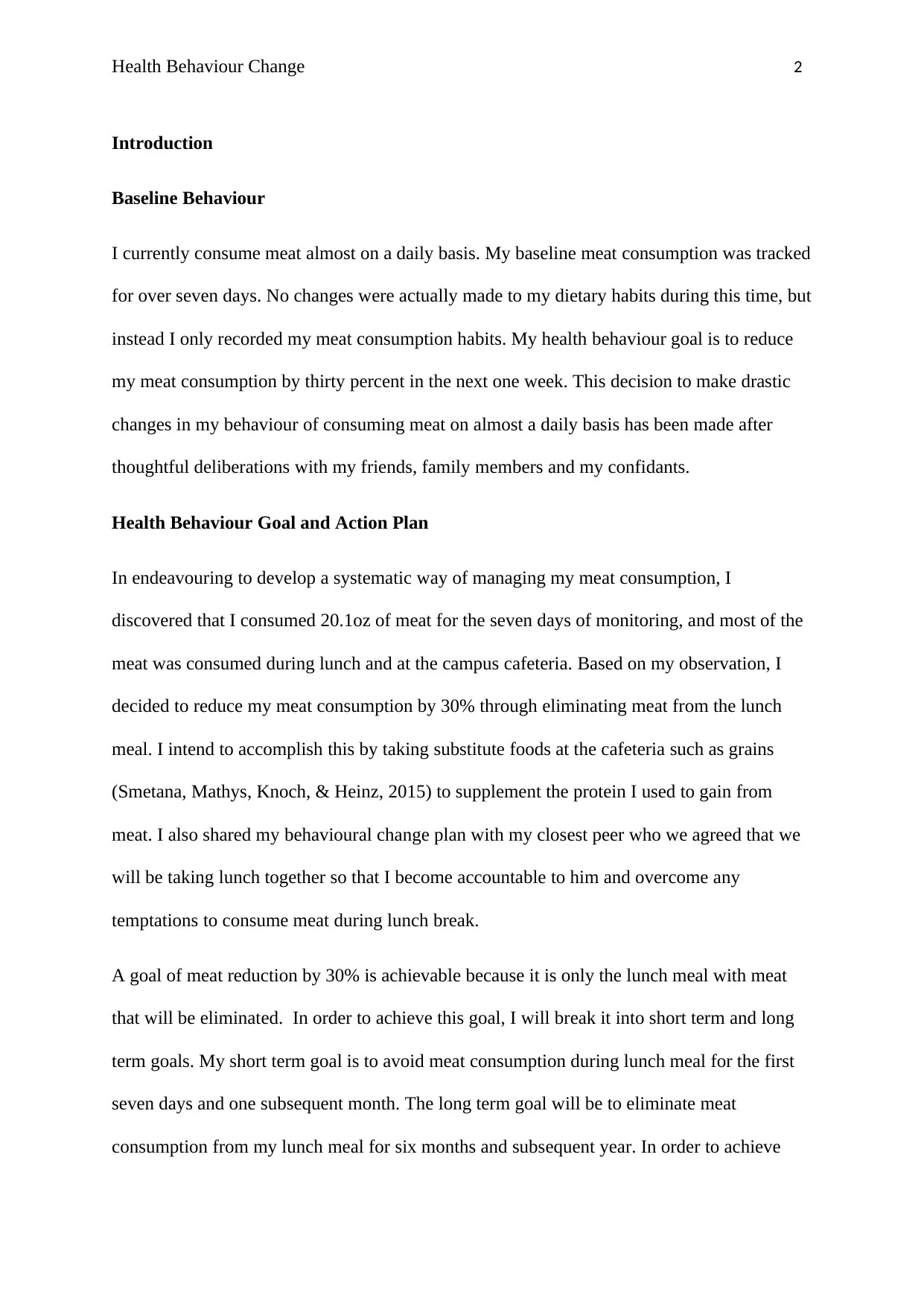
Health Behaviour Change 2
Introduction
Baseline Behaviour
I currently consume meat almost on a daily basis. My baseline meat consumption was tracked
for over seven days. No changes were actually made to my dietary habits during this time, but
instead I only recorded my meat consumption habits. My health behaviour goal is to reduce
my meat consumption by thirty percent in the next one week. This decision to make drastic
changes in my behaviour of consuming meat on almost a daily basis has been made after
thoughtful deliberations with my friends, family members and my confidants.
Health Behaviour Goal and Action Plan
In endeavouring to develop a systematic way of managing my meat consumption, I
discovered that I consumed 20.1oz of meat for the seven days of monitoring, and most of the
meat was consumed during lunch and at the campus cafeteria. Based on my observation, I
decided to reduce my meat consumption by 30% through eliminating meat from the lunch
meal. I intend to accomplish this by taking substitute foods at the cafeteria such as grains
(Smetana, Mathys, Knoch, & Heinz, 2015) to supplement the protein I used to gain from
meat. I also shared my behavioural change plan with my closest peer who we agreed that we
will be taking lunch together so that I become accountable to him and overcome any
temptations to consume meat during lunch break.
A goal of meat reduction by 30% is achievable because it is only the lunch meal with meat
that will be eliminated. In order to achieve this goal, I will break it into short term and long
term goals. My short term goal is to avoid meat consumption during lunch meal for the first
seven days and one subsequent month. The long term goal will be to eliminate meat
consumption from my lunch meal for six months and subsequent year. In order to achieve
Introduction
Baseline Behaviour
I currently consume meat almost on a daily basis. My baseline meat consumption was tracked
for over seven days. No changes were actually made to my dietary habits during this time, but
instead I only recorded my meat consumption habits. My health behaviour goal is to reduce
my meat consumption by thirty percent in the next one week. This decision to make drastic
changes in my behaviour of consuming meat on almost a daily basis has been made after
thoughtful deliberations with my friends, family members and my confidants.
Health Behaviour Goal and Action Plan
In endeavouring to develop a systematic way of managing my meat consumption, I
discovered that I consumed 20.1oz of meat for the seven days of monitoring, and most of the
meat was consumed during lunch and at the campus cafeteria. Based on my observation, I
decided to reduce my meat consumption by 30% through eliminating meat from the lunch
meal. I intend to accomplish this by taking substitute foods at the cafeteria such as grains
(Smetana, Mathys, Knoch, & Heinz, 2015) to supplement the protein I used to gain from
meat. I also shared my behavioural change plan with my closest peer who we agreed that we
will be taking lunch together so that I become accountable to him and overcome any
temptations to consume meat during lunch break.
A goal of meat reduction by 30% is achievable because it is only the lunch meal with meat
that will be eliminated. In order to achieve this goal, I will break it into short term and long
term goals. My short term goal is to avoid meat consumption during lunch meal for the first
seven days and one subsequent month. The long term goal will be to eliminate meat
consumption from my lunch meal for six months and subsequent year. In order to achieve
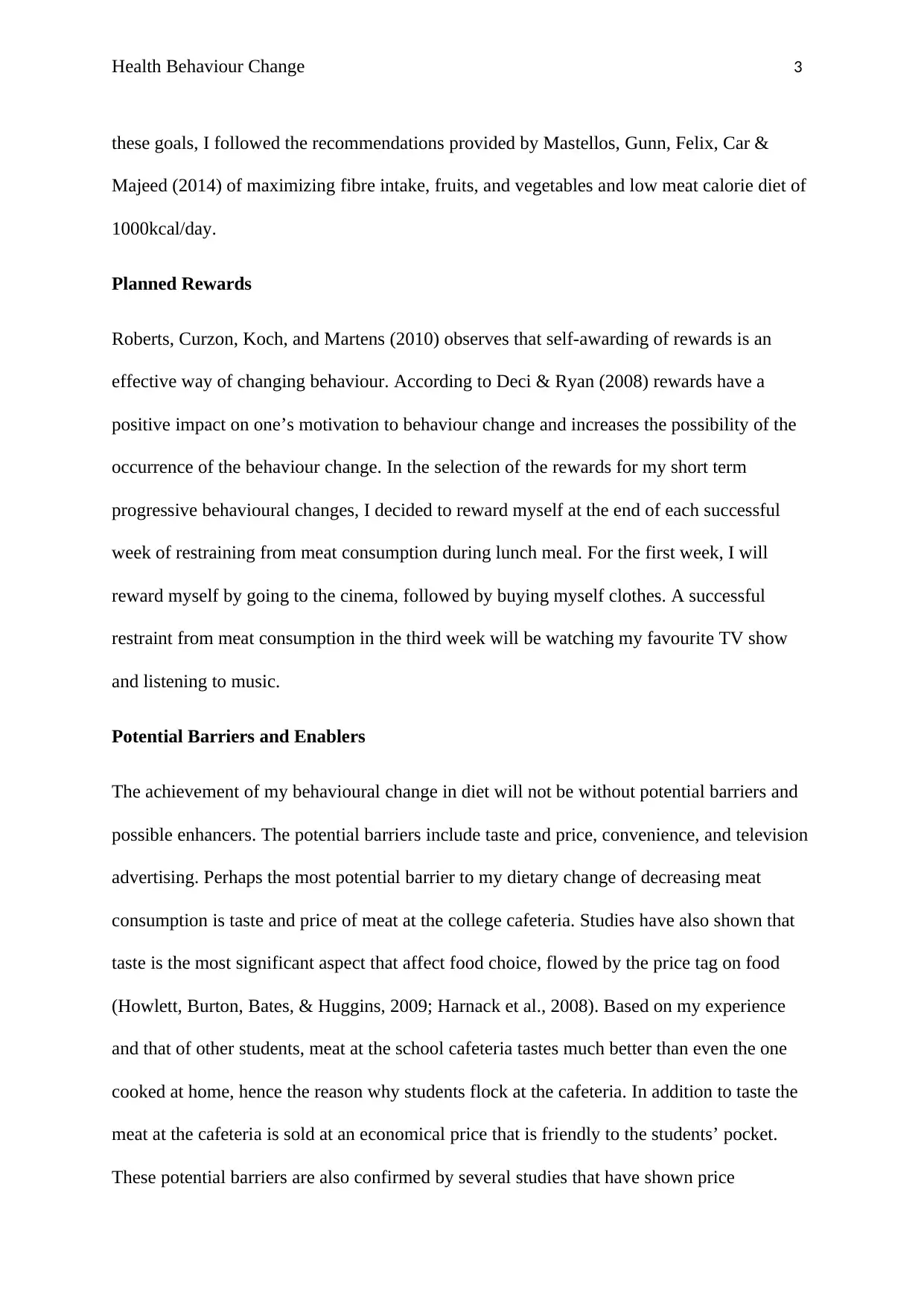
Health Behaviour Change 3
these goals, I followed the recommendations provided by Mastellos, Gunn, Felix, Car &
Majeed (2014) of maximizing fibre intake, fruits, and vegetables and low meat calorie diet of
1000kcal/day.
Planned Rewards
Roberts, Curzon, Koch, and Martens (2010) observes that self-awarding of rewards is an
effective way of changing behaviour. According to Deci & Ryan (2008) rewards have a
positive impact on one’s motivation to behaviour change and increases the possibility of the
occurrence of the behaviour change. In the selection of the rewards for my short term
progressive behavioural changes, I decided to reward myself at the end of each successful
week of restraining from meat consumption during lunch meal. For the first week, I will
reward myself by going to the cinema, followed by buying myself clothes. A successful
restraint from meat consumption in the third week will be watching my favourite TV show
and listening to music.
Potential Barriers and Enablers
The achievement of my behavioural change in diet will not be without potential barriers and
possible enhancers. The potential barriers include taste and price, convenience, and television
advertising. Perhaps the most potential barrier to my dietary change of decreasing meat
consumption is taste and price of meat at the college cafeteria. Studies have also shown that
taste is the most significant aspect that affect food choice, flowed by the price tag on food
(Howlett, Burton, Bates, & Huggins, 2009; Harnack et al., 2008). Based on my experience
and that of other students, meat at the school cafeteria tastes much better than even the one
cooked at home, hence the reason why students flock at the cafeteria. In addition to taste the
meat at the cafeteria is sold at an economical price that is friendly to the students’ pocket.
These potential barriers are also confirmed by several studies that have shown price
these goals, I followed the recommendations provided by Mastellos, Gunn, Felix, Car &
Majeed (2014) of maximizing fibre intake, fruits, and vegetables and low meat calorie diet of
1000kcal/day.
Planned Rewards
Roberts, Curzon, Koch, and Martens (2010) observes that self-awarding of rewards is an
effective way of changing behaviour. According to Deci & Ryan (2008) rewards have a
positive impact on one’s motivation to behaviour change and increases the possibility of the
occurrence of the behaviour change. In the selection of the rewards for my short term
progressive behavioural changes, I decided to reward myself at the end of each successful
week of restraining from meat consumption during lunch meal. For the first week, I will
reward myself by going to the cinema, followed by buying myself clothes. A successful
restraint from meat consumption in the third week will be watching my favourite TV show
and listening to music.
Potential Barriers and Enablers
The achievement of my behavioural change in diet will not be without potential barriers and
possible enhancers. The potential barriers include taste and price, convenience, and television
advertising. Perhaps the most potential barrier to my dietary change of decreasing meat
consumption is taste and price of meat at the college cafeteria. Studies have also shown that
taste is the most significant aspect that affect food choice, flowed by the price tag on food
(Howlett, Burton, Bates, & Huggins, 2009; Harnack et al., 2008). Based on my experience
and that of other students, meat at the school cafeteria tastes much better than even the one
cooked at home, hence the reason why students flock at the cafeteria. In addition to taste the
meat at the cafeteria is sold at an economical price that is friendly to the students’ pocket.
These potential barriers are also confirmed by several studies that have shown price
⊘ This is a preview!⊘
Do you want full access?
Subscribe today to unlock all pages.

Trusted by 1+ million students worldwide
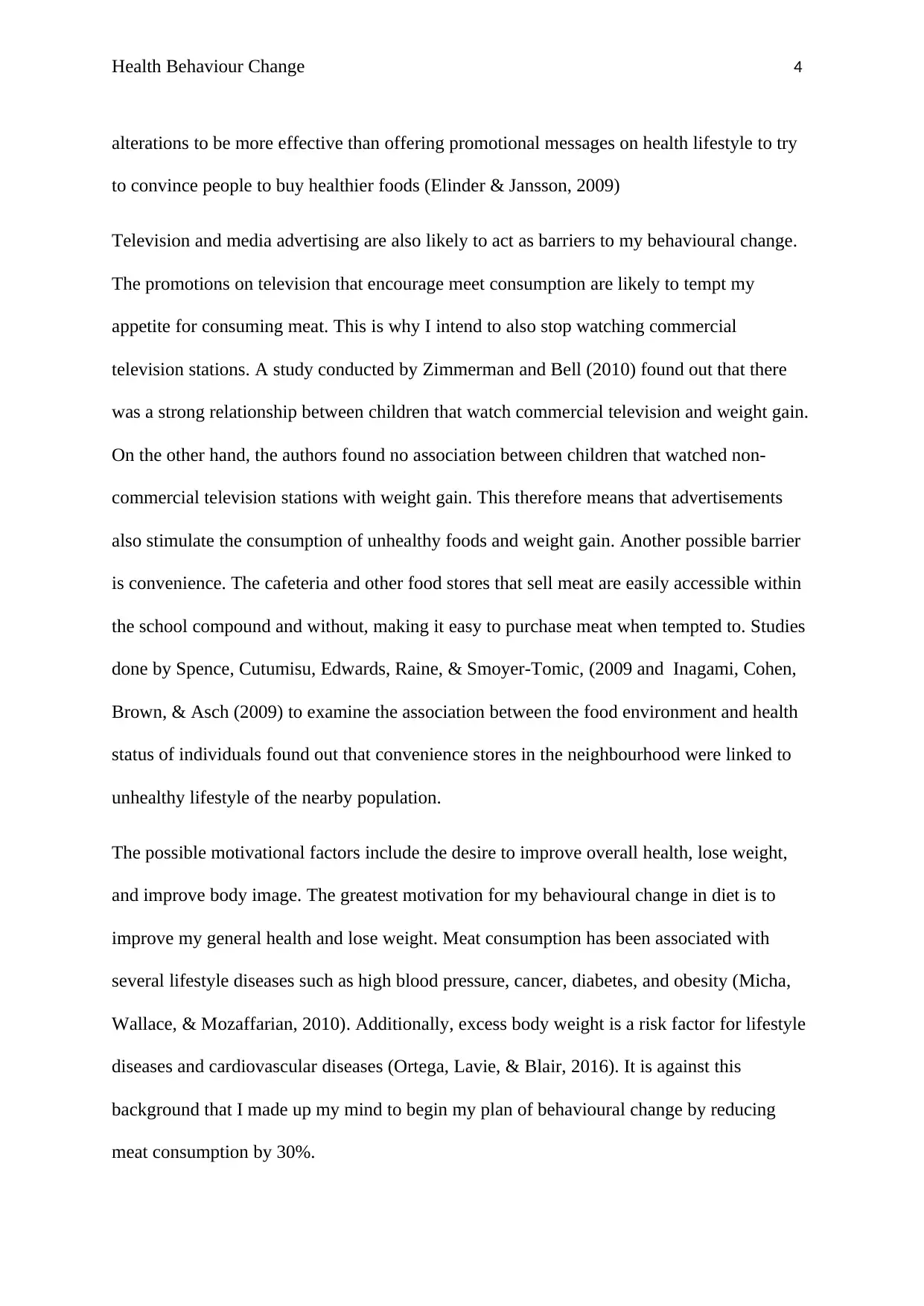
Health Behaviour Change 4
alterations to be more effective than offering promotional messages on health lifestyle to try
to convince people to buy healthier foods (Elinder & Jansson, 2009)
Television and media advertising are also likely to act as barriers to my behavioural change.
The promotions on television that encourage meet consumption are likely to tempt my
appetite for consuming meat. This is why I intend to also stop watching commercial
television stations. A study conducted by Zimmerman and Bell (2010) found out that there
was a strong relationship between children that watch commercial television and weight gain.
On the other hand, the authors found no association between children that watched non-
commercial television stations with weight gain. This therefore means that advertisements
also stimulate the consumption of unhealthy foods and weight gain. Another possible barrier
is convenience. The cafeteria and other food stores that sell meat are easily accessible within
the school compound and without, making it easy to purchase meat when tempted to. Studies
done by Spence, Cutumisu, Edwards, Raine, & Smoyer-Tomic, (2009 and Inagami, Cohen,
Brown, & Asch (2009) to examine the association between the food environment and health
status of individuals found out that convenience stores in the neighbourhood were linked to
unhealthy lifestyle of the nearby population.
The possible motivational factors include the desire to improve overall health, lose weight,
and improve body image. The greatest motivation for my behavioural change in diet is to
improve my general health and lose weight. Meat consumption has been associated with
several lifestyle diseases such as high blood pressure, cancer, diabetes, and obesity (Micha,
Wallace, & Mozaffarian, 2010). Additionally, excess body weight is a risk factor for lifestyle
diseases and cardiovascular diseases (Ortega, Lavie, & Blair, 2016). It is against this
background that I made up my mind to begin my plan of behavioural change by reducing
meat consumption by 30%.
alterations to be more effective than offering promotional messages on health lifestyle to try
to convince people to buy healthier foods (Elinder & Jansson, 2009)
Television and media advertising are also likely to act as barriers to my behavioural change.
The promotions on television that encourage meet consumption are likely to tempt my
appetite for consuming meat. This is why I intend to also stop watching commercial
television stations. A study conducted by Zimmerman and Bell (2010) found out that there
was a strong relationship between children that watch commercial television and weight gain.
On the other hand, the authors found no association between children that watched non-
commercial television stations with weight gain. This therefore means that advertisements
also stimulate the consumption of unhealthy foods and weight gain. Another possible barrier
is convenience. The cafeteria and other food stores that sell meat are easily accessible within
the school compound and without, making it easy to purchase meat when tempted to. Studies
done by Spence, Cutumisu, Edwards, Raine, & Smoyer-Tomic, (2009 and Inagami, Cohen,
Brown, & Asch (2009) to examine the association between the food environment and health
status of individuals found out that convenience stores in the neighbourhood were linked to
unhealthy lifestyle of the nearby population.
The possible motivational factors include the desire to improve overall health, lose weight,
and improve body image. The greatest motivation for my behavioural change in diet is to
improve my general health and lose weight. Meat consumption has been associated with
several lifestyle diseases such as high blood pressure, cancer, diabetes, and obesity (Micha,
Wallace, & Mozaffarian, 2010). Additionally, excess body weight is a risk factor for lifestyle
diseases and cardiovascular diseases (Ortega, Lavie, & Blair, 2016). It is against this
background that I made up my mind to begin my plan of behavioural change by reducing
meat consumption by 30%.
Paraphrase This Document
Need a fresh take? Get an instant paraphrase of this document with our AI Paraphraser
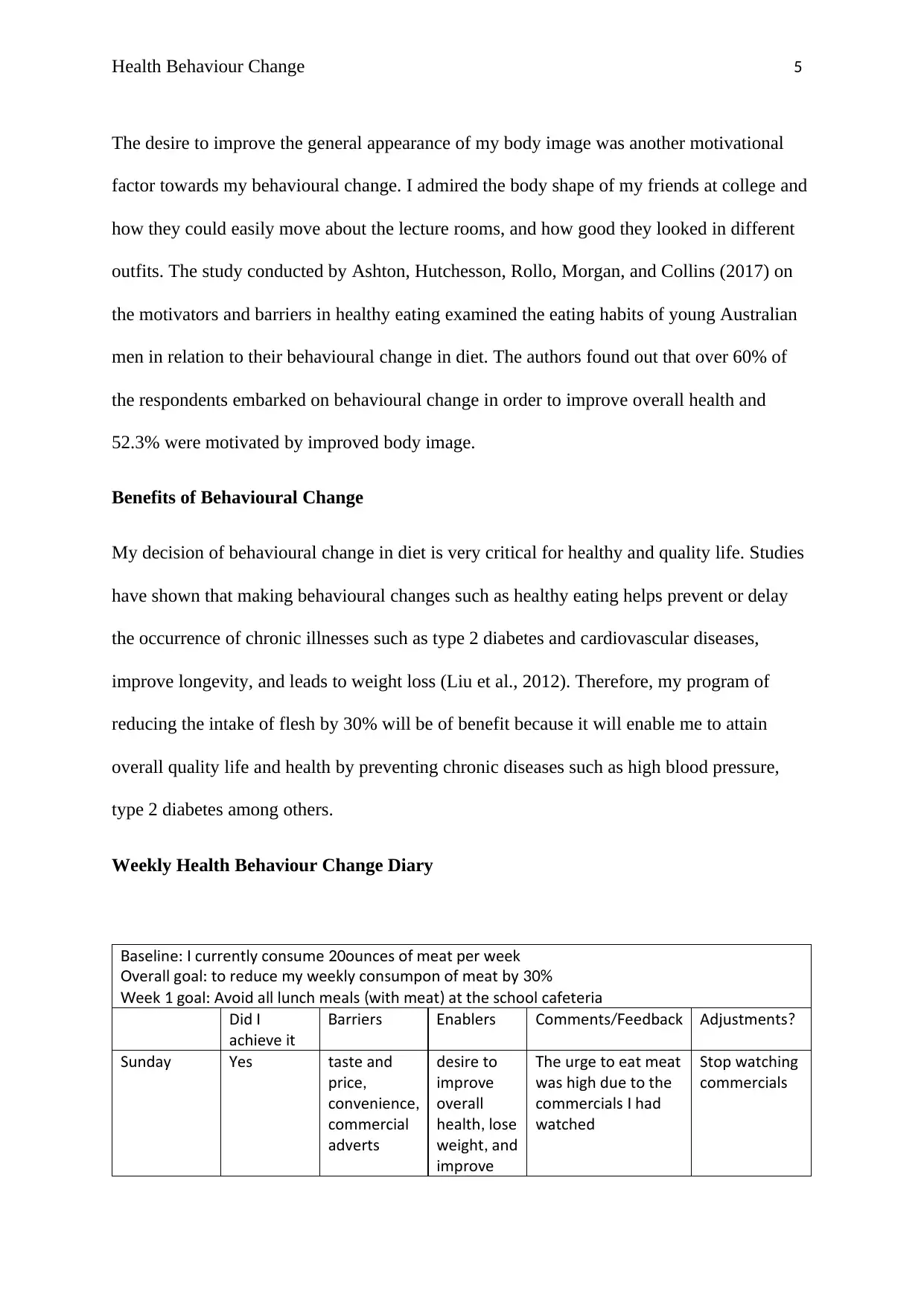
Health Behaviour Change 5
The desire to improve the general appearance of my body image was another motivational
factor towards my behavioural change. I admired the body shape of my friends at college and
how they could easily move about the lecture rooms, and how good they looked in different
outfits. The study conducted by Ashton, Hutchesson, Rollo, Morgan, and Collins (2017) on
the motivators and barriers in healthy eating examined the eating habits of young Australian
men in relation to their behavioural change in diet. The authors found out that over 60% of
the respondents embarked on behavioural change in order to improve overall health and
52.3% were motivated by improved body image.
Benefits of Behavioural Change
My decision of behavioural change in diet is very critical for healthy and quality life. Studies
have shown that making behavioural changes such as healthy eating helps prevent or delay
the occurrence of chronic illnesses such as type 2 diabetes and cardiovascular diseases,
improve longevity, and leads to weight loss (Liu et al., 2012). Therefore, my program of
reducing the intake of flesh by 30% will be of benefit because it will enable me to attain
overall quality life and health by preventing chronic diseases such as high blood pressure,
type 2 diabetes among others.
Weekly Health Behaviour Change Diary
aseline currently consume ounces of meat per weekB : I 20
verall goal to reduce my weekly consumption of meat byO : 30%
eek goal Avoid all lunch meals with meat at the school cafeteriaW 1 : ( )
Did I
achieve it
arriersB nablersE Comments eedback/F Adjustments?
Sunday esY taste and
price,
convenience,
commercial
adverts
desire to
improve
overall
health lose,
weight and,
improve
he urge to eat meatT
was high due to the
commercials hadI
watched
Stop watching
commercials
The desire to improve the general appearance of my body image was another motivational
factor towards my behavioural change. I admired the body shape of my friends at college and
how they could easily move about the lecture rooms, and how good they looked in different
outfits. The study conducted by Ashton, Hutchesson, Rollo, Morgan, and Collins (2017) on
the motivators and barriers in healthy eating examined the eating habits of young Australian
men in relation to their behavioural change in diet. The authors found out that over 60% of
the respondents embarked on behavioural change in order to improve overall health and
52.3% were motivated by improved body image.
Benefits of Behavioural Change
My decision of behavioural change in diet is very critical for healthy and quality life. Studies
have shown that making behavioural changes such as healthy eating helps prevent or delay
the occurrence of chronic illnesses such as type 2 diabetes and cardiovascular diseases,
improve longevity, and leads to weight loss (Liu et al., 2012). Therefore, my program of
reducing the intake of flesh by 30% will be of benefit because it will enable me to attain
overall quality life and health by preventing chronic diseases such as high blood pressure,
type 2 diabetes among others.
Weekly Health Behaviour Change Diary
aseline currently consume ounces of meat per weekB : I 20
verall goal to reduce my weekly consumption of meat byO : 30%
eek goal Avoid all lunch meals with meat at the school cafeteriaW 1 : ( )
Did I
achieve it
arriersB nablersE Comments eedback/F Adjustments?
Sunday esY taste and
price,
convenience,
commercial
adverts
desire to
improve
overall
health lose,
weight and,
improve
he urge to eat meatT
was high due to the
commercials hadI
watched
Stop watching
commercials
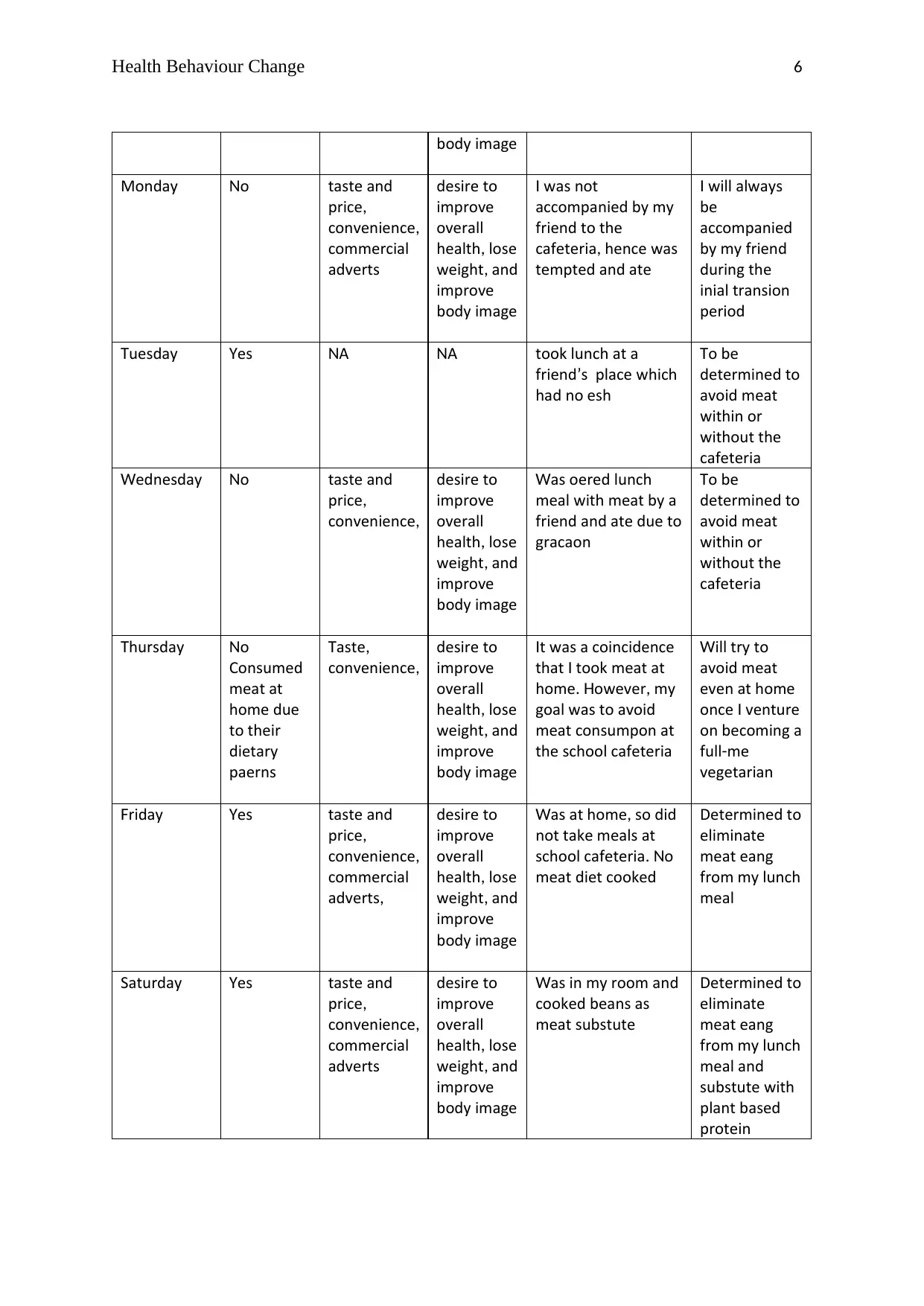
Health Behaviour Change 6
body image
Monday oN taste and
price,
convenience,
commercial
adverts
desire to
improve
overall
health lose,
weight and,
improve
body image
was notI
accompanied by my
friend to the
cafeteria hence was,
tempted and ate
will alwaysI
be
accompanied
by my friend
during the
initial transition
period
uesdayT esY AN AN took lunch at a
friend s place which’
had no fl esh
o beT
determined to
avoid meat
within or
without the
cafeteria
ednesdayW oN taste and
price,
convenience,
desire to
improve
overall
health lose,
weight and,
improve
body image
as offered lunchW
meal with meat by a
friend and ate due to
gratification
o beT
determined to
avoid meat
within or
without the
cafeteria
hursdayT oN
Consumed
meat at
home due
to their
dietary
patterns
asteT ,
convenience,
desire to
improve
overall
health lose,
weight and,
improve
body image
t was a coincidenceI
that took meat atI
home owever my. H ,
goal was to avoid
meat consumption at
the school cafeteria
ill try toW
avoid meat
even at home
once ventureI
on becoming a
full ti me-
vegetarian
ridayF esY taste and
price,
convenience,
commercial
adverts,
desire to
improve
overall
health lose,
weight and,
improve
body image
as at home so didW ,
not take meals at
school cafeteria o. N
meat diet cooked
Determined to
eliminate
meat eating
from my lunch
meal
Saturday esY taste and
price,
convenience,
commercial
adverts
desire to
improve
overall
health lose,
weight and,
improve
body image
as in my room andW
cooked beans as
meat substitute
Determined to
eliminate
meat eating
from my lunch
meal and
substitute with
plant based
protein
body image
Monday oN taste and
price,
convenience,
commercial
adverts
desire to
improve
overall
health lose,
weight and,
improve
body image
was notI
accompanied by my
friend to the
cafeteria hence was,
tempted and ate
will alwaysI
be
accompanied
by my friend
during the
initial transition
period
uesdayT esY AN AN took lunch at a
friend s place which’
had no fl esh
o beT
determined to
avoid meat
within or
without the
cafeteria
ednesdayW oN taste and
price,
convenience,
desire to
improve
overall
health lose,
weight and,
improve
body image
as offered lunchW
meal with meat by a
friend and ate due to
gratification
o beT
determined to
avoid meat
within or
without the
cafeteria
hursdayT oN
Consumed
meat at
home due
to their
dietary
patterns
asteT ,
convenience,
desire to
improve
overall
health lose,
weight and,
improve
body image
t was a coincidenceI
that took meat atI
home owever my. H ,
goal was to avoid
meat consumption at
the school cafeteria
ill try toW
avoid meat
even at home
once ventureI
on becoming a
full ti me-
vegetarian
ridayF esY taste and
price,
convenience,
commercial
adverts,
desire to
improve
overall
health lose,
weight and,
improve
body image
as at home so didW ,
not take meals at
school cafeteria o. N
meat diet cooked
Determined to
eliminate
meat eating
from my lunch
meal
Saturday esY taste and
price,
convenience,
commercial
adverts
desire to
improve
overall
health lose,
weight and,
improve
body image
as in my room andW
cooked beans as
meat substitute
Determined to
eliminate
meat eating
from my lunch
meal and
substitute with
plant based
protein
⊘ This is a preview!⊘
Do you want full access?
Subscribe today to unlock all pages.

Trusted by 1+ million students worldwide
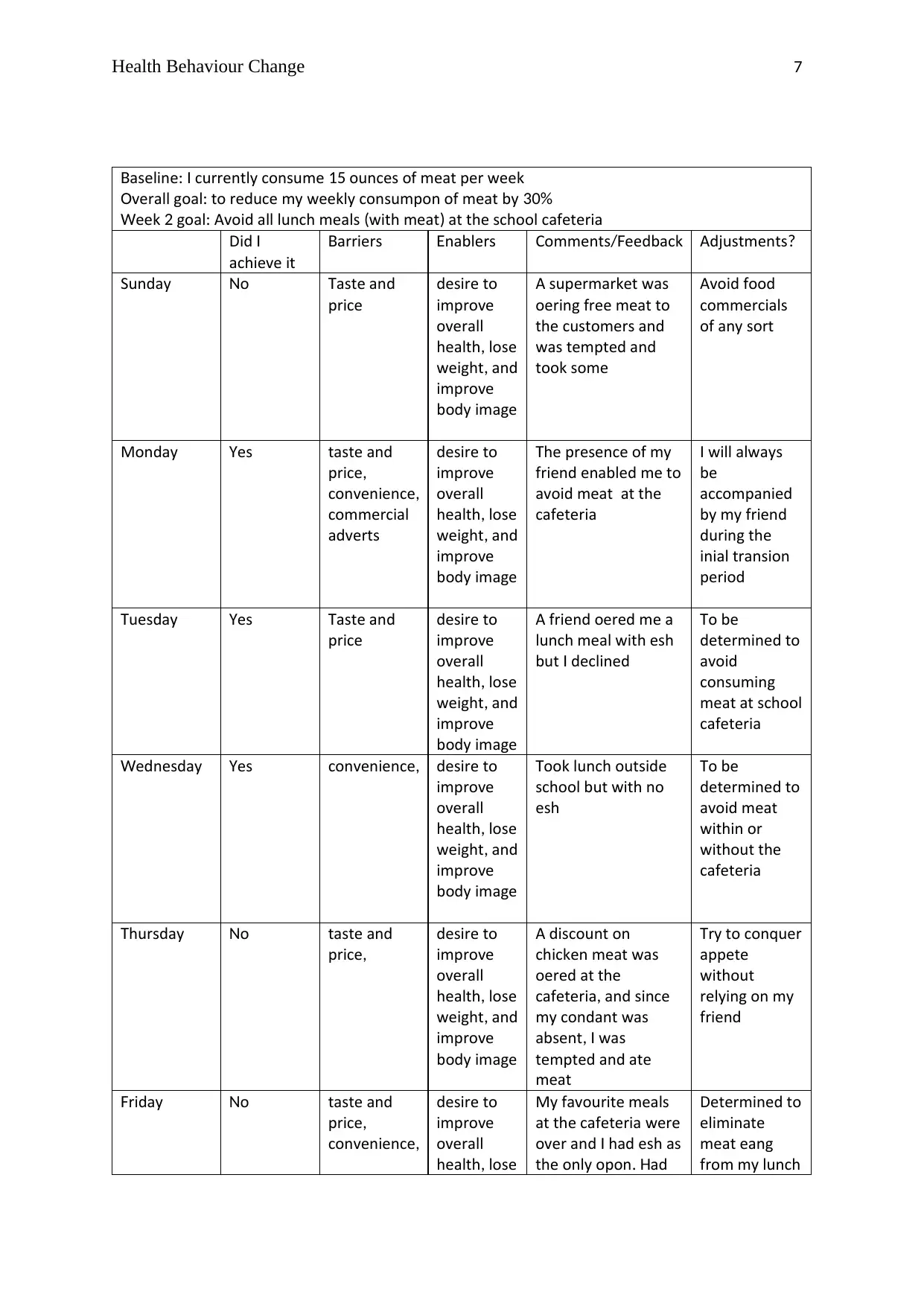
Health Behaviour Change 7
aseline currently consume ounces of meat per weekB : I 15
verall goal to reduce my weekly consumption of meat byO : 30%
eek goal Avoid all lunch meals with meat at the school cafeteriaW 2 : ( )
Did I
achieve it
arriersB nablersE Comments eedback/F Adjustments?
Sunday oN aste andT
price
desire to
improve
overall
health lose,
weight and,
improve
body image
A supermarket was
offering free meat to
the customers and
was tempted and
took some
Avoid food
commercials
of any sort
Monday esY taste and
price,
convenience,
commercial
adverts
desire to
improve
overall
health lose,
weight and,
improve
body image
he presence of myT
friend enabled me to
avoid meat at the
cafeteria
will alwaysI
be
accompanied
by my friend
during the
initial transition
period
uesdayT esY aste andT
price
desire to
improve
overall
health lose,
weight and,
improve
body image
A friend offered me a
lunch meal with fl esh
but declinedI
o beT
determined to
avoid
consuming
meat at school
cafeteria
ednesdayW esY convenience, desire to
improve
overall
health lose,
weight and,
improve
body image
ook lunch outsideT
school but with no
fl
esh
o beT
determined to
avoid meat
within or
without the
cafeteria
hursdayT oN taste and
price,
desire to
improve
overall
health lose,
weight and,
improve
body image
A discount on
chicken meat was
offered at the
cafeteria and since,
my confidant was
absent was, I
tempted and ate
meat
ry to conquerT
appetite
without
relying on my
friend
ridayF oN taste and
price,
convenience,
desire to
improve
overall
health lose,
My favourite meals
at the cafeteria were
over and had fl esh asI
the only option ad. H
Determined to
eliminate
meat eating
from my lunch
aseline currently consume ounces of meat per weekB : I 15
verall goal to reduce my weekly consumption of meat byO : 30%
eek goal Avoid all lunch meals with meat at the school cafeteriaW 2 : ( )
Did I
achieve it
arriersB nablersE Comments eedback/F Adjustments?
Sunday oN aste andT
price
desire to
improve
overall
health lose,
weight and,
improve
body image
A supermarket was
offering free meat to
the customers and
was tempted and
took some
Avoid food
commercials
of any sort
Monday esY taste and
price,
convenience,
commercial
adverts
desire to
improve
overall
health lose,
weight and,
improve
body image
he presence of myT
friend enabled me to
avoid meat at the
cafeteria
will alwaysI
be
accompanied
by my friend
during the
initial transition
period
uesdayT esY aste andT
price
desire to
improve
overall
health lose,
weight and,
improve
body image
A friend offered me a
lunch meal with fl esh
but declinedI
o beT
determined to
avoid
consuming
meat at school
cafeteria
ednesdayW esY convenience, desire to
improve
overall
health lose,
weight and,
improve
body image
ook lunch outsideT
school but with no
fl
esh
o beT
determined to
avoid meat
within or
without the
cafeteria
hursdayT oN taste and
price,
desire to
improve
overall
health lose,
weight and,
improve
body image
A discount on
chicken meat was
offered at the
cafeteria and since,
my confidant was
absent was, I
tempted and ate
meat
ry to conquerT
appetite
without
relying on my
friend
ridayF oN taste and
price,
convenience,
desire to
improve
overall
health lose,
My favourite meals
at the cafeteria were
over and had fl esh asI
the only option ad. H
Determined to
eliminate
meat eating
from my lunch
Paraphrase This Document
Need a fresh take? Get an instant paraphrase of this document with our AI Paraphraser
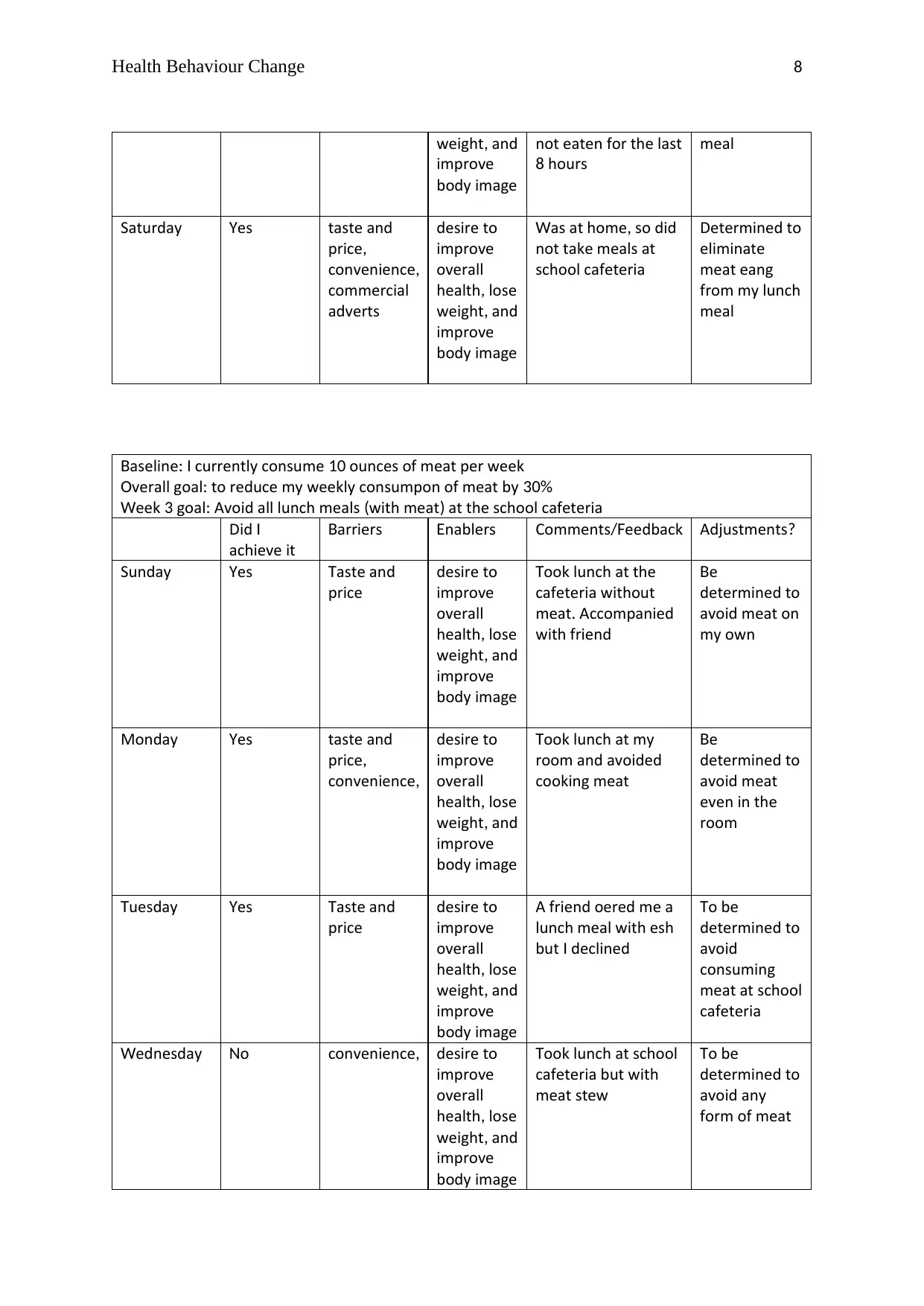
Health Behaviour Change 8
weight and,
improve
body image
not eaten for the last
hours8
meal
Saturday esY taste and
price,
convenience,
commercial
adverts
desire to
improve
overall
health lose,
weight and,
improve
body image
as at home so didW ,
not take meals at
school cafeteria
Determined to
eliminate
meat eating
from my lunch
meal
aseline currently consume ounces of meat per weekB : I 10
verall goal to reduce my weekly consumption of meat byO : 30%
eek goal Avoid all lunch meals with meat at the school cafeteriaW 3 : ( )
Did I
achieve it
arriersB nablersE Comments eedback/F Adjustments?
Sunday esY aste andT
price
desire to
improve
overall
health lose,
weight and,
improve
body image
ook lunch at theT
cafeteria without
meat Accompanied.
with friend
eB
determined to
avoid meat on
my own
Monday esY taste and
price,
convenience,
desire to
improve
overall
health lose,
weight and,
improve
body image
ook lunch at myT
room and avoided
cooking meat
eB
determined to
avoid meat
even in the
room
uesdayT esY aste andT
price
desire to
improve
overall
health lose,
weight and,
improve
body image
A friend offered me a
lunch meal with fl esh
but declinedI
o beT
determined to
avoid
consuming
meat at school
cafeteria
ednesdayW oN convenience, desire to
improve
overall
health lose,
weight and,
improve
body image
ook lunch at schoolT
cafeteria but with
meat stew
o beT
determined to
avoid any
form of meat
weight and,
improve
body image
not eaten for the last
hours8
meal
Saturday esY taste and
price,
convenience,
commercial
adverts
desire to
improve
overall
health lose,
weight and,
improve
body image
as at home so didW ,
not take meals at
school cafeteria
Determined to
eliminate
meat eating
from my lunch
meal
aseline currently consume ounces of meat per weekB : I 10
verall goal to reduce my weekly consumption of meat byO : 30%
eek goal Avoid all lunch meals with meat at the school cafeteriaW 3 : ( )
Did I
achieve it
arriersB nablersE Comments eedback/F Adjustments?
Sunday esY aste andT
price
desire to
improve
overall
health lose,
weight and,
improve
body image
ook lunch at theT
cafeteria without
meat Accompanied.
with friend
eB
determined to
avoid meat on
my own
Monday esY taste and
price,
convenience,
desire to
improve
overall
health lose,
weight and,
improve
body image
ook lunch at myT
room and avoided
cooking meat
eB
determined to
avoid meat
even in the
room
uesdayT esY aste andT
price
desire to
improve
overall
health lose,
weight and,
improve
body image
A friend offered me a
lunch meal with fl esh
but declinedI
o beT
determined to
avoid
consuming
meat at school
cafeteria
ednesdayW oN convenience, desire to
improve
overall
health lose,
weight and,
improve
body image
ook lunch at schoolT
cafeteria but with
meat stew
o beT
determined to
avoid any
form of meat
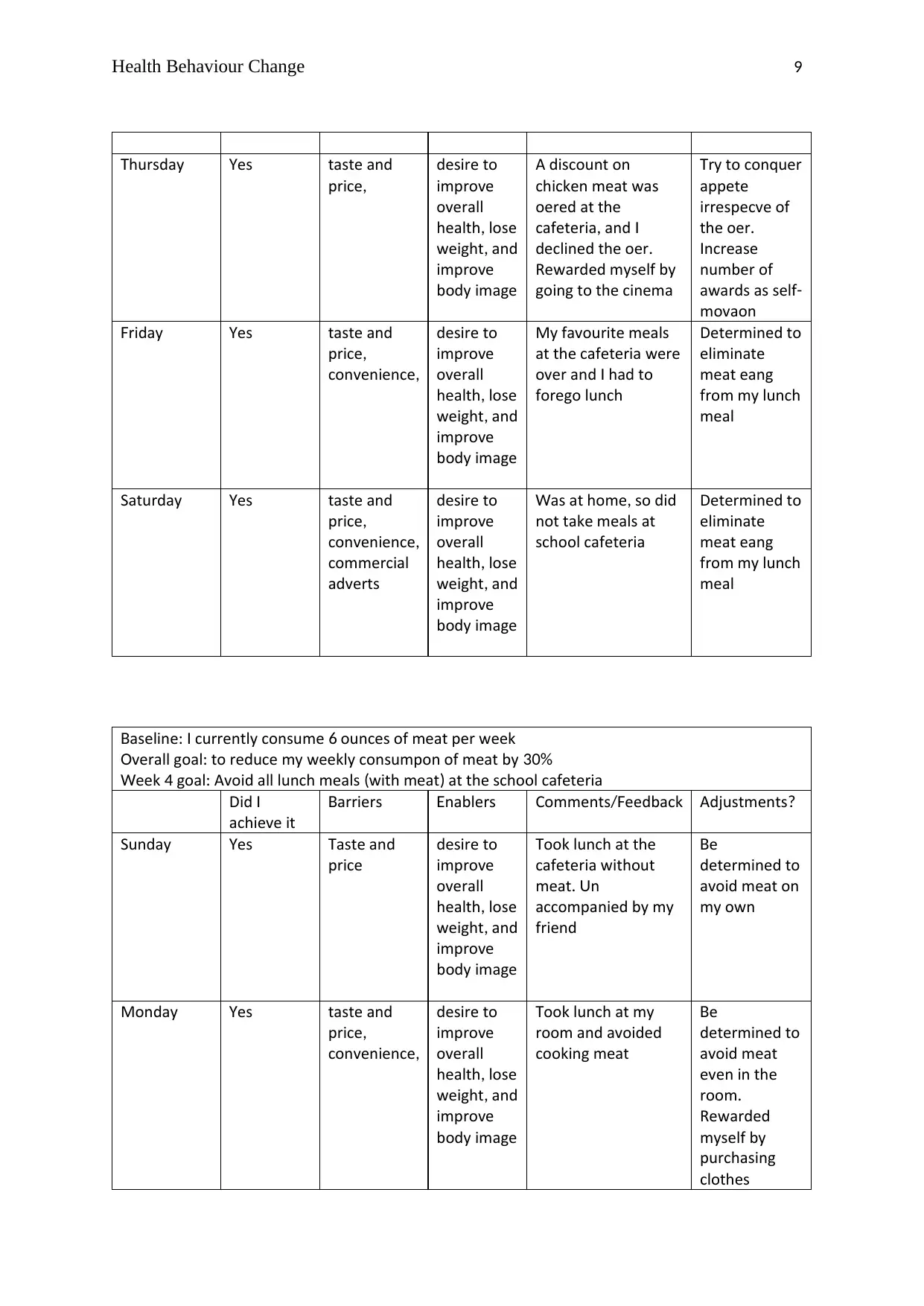
Health Behaviour Change 9
hursdayT esY taste and
price,
desire to
improve
overall
health lose,
weight and,
improve
body image
A discount on
chicken meat was
offered at the
cafeteria and, I
declined the offer.
Rewarded myself by
going to the cinema
ry to conquerT
appetite
irrespective of
the offer.
ncreaseI
number of
awards as self-
motivation
ridayF esY taste and
price,
convenience,
desire to
improve
overall
health lose,
weight and,
improve
body image
My favourite meals
at the cafeteria were
over and had toI
forego lunch
Determined to
eliminate
meat eating
from my lunch
meal
Saturday esY taste and
price,
convenience,
commercial
adverts
desire to
improve
overall
health lose,
weight and,
improve
body image
as at home so didW ,
not take meals at
school cafeteria
Determined to
eliminate
meat eating
from my lunch
meal
aseline currently consume ounces of meat per weekB : I 6
verall goal to reduce my weekly consumption of meat byO : 30%
eek goal Avoid all lunch meals with meat at the school cafeteriaW 4 : ( )
Did I
achieve it
arriersB nablersE Comments eedback/F Adjustments?
Sunday esY aste andT
price
desire to
improve
overall
health lose,
weight and,
improve
body image
ook lunch at theT
cafeteria without
meat n. U
accompanied by my
friend
eB
determined to
avoid meat on
my own
Monday esY taste and
price,
convenience,
desire to
improve
overall
health lose,
weight and,
improve
body image
ook lunch at myT
room and avoided
cooking meat
eB
determined to
avoid meat
even in the
room.
Rewarded
myself by
purchasing
clothes
hursdayT esY taste and
price,
desire to
improve
overall
health lose,
weight and,
improve
body image
A discount on
chicken meat was
offered at the
cafeteria and, I
declined the offer.
Rewarded myself by
going to the cinema
ry to conquerT
appetite
irrespective of
the offer.
ncreaseI
number of
awards as self-
motivation
ridayF esY taste and
price,
convenience,
desire to
improve
overall
health lose,
weight and,
improve
body image
My favourite meals
at the cafeteria were
over and had toI
forego lunch
Determined to
eliminate
meat eating
from my lunch
meal
Saturday esY taste and
price,
convenience,
commercial
adverts
desire to
improve
overall
health lose,
weight and,
improve
body image
as at home so didW ,
not take meals at
school cafeteria
Determined to
eliminate
meat eating
from my lunch
meal
aseline currently consume ounces of meat per weekB : I 6
verall goal to reduce my weekly consumption of meat byO : 30%
eek goal Avoid all lunch meals with meat at the school cafeteriaW 4 : ( )
Did I
achieve it
arriersB nablersE Comments eedback/F Adjustments?
Sunday esY aste andT
price
desire to
improve
overall
health lose,
weight and,
improve
body image
ook lunch at theT
cafeteria without
meat n. U
accompanied by my
friend
eB
determined to
avoid meat on
my own
Monday esY taste and
price,
convenience,
desire to
improve
overall
health lose,
weight and,
improve
body image
ook lunch at myT
room and avoided
cooking meat
eB
determined to
avoid meat
even in the
room.
Rewarded
myself by
purchasing
clothes
⊘ This is a preview!⊘
Do you want full access?
Subscribe today to unlock all pages.

Trusted by 1+ million students worldwide
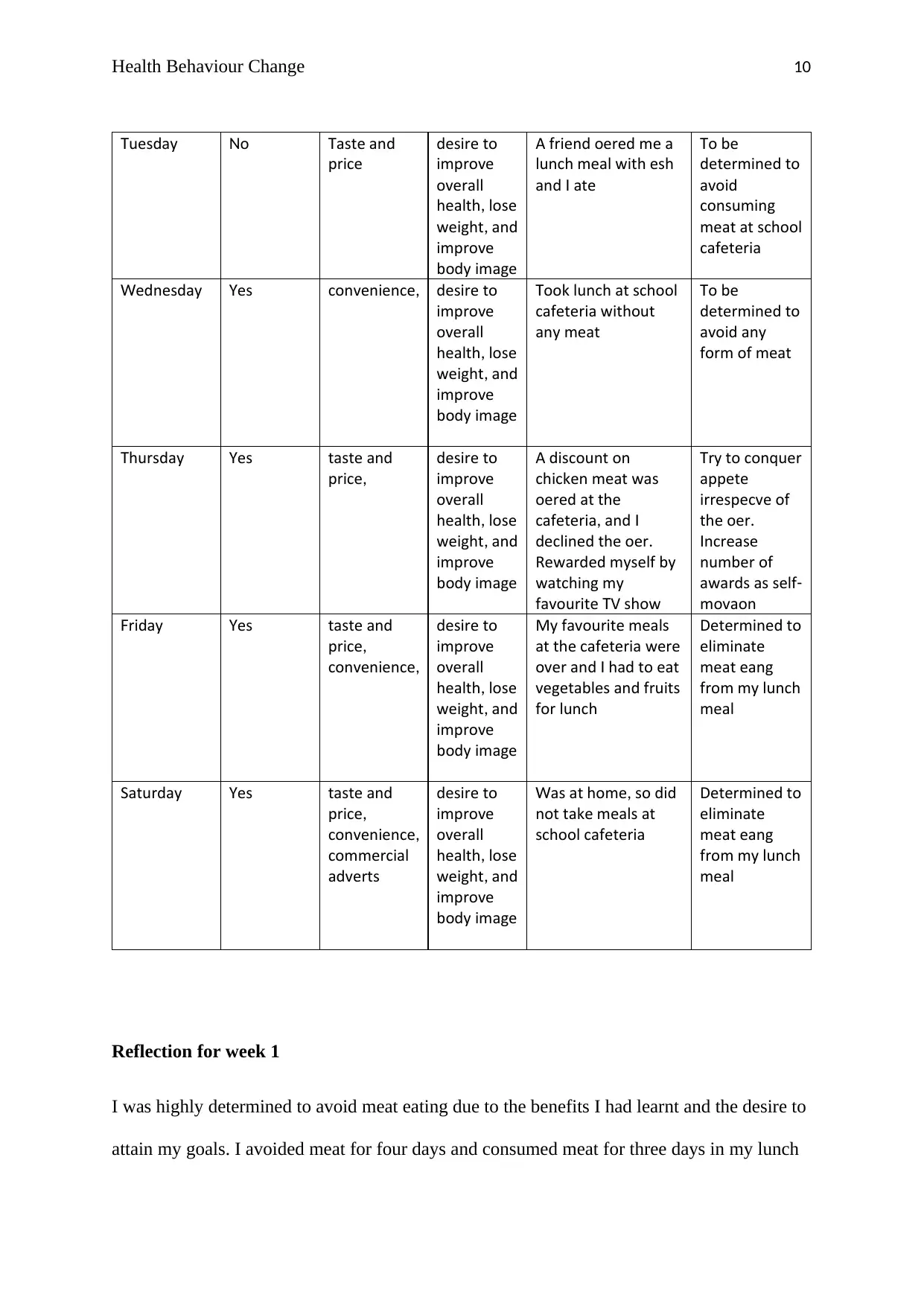
Health Behaviour Change 10
uesdayT oN aste andT
price
desire to
improve
overall
health lose,
weight and,
improve
body image
A friend offered me a
lunch meal with fl esh
and ateI
o beT
determined to
avoid
consuming
meat at school
cafeteria
ednesdayW esY convenience, desire to
improve
overall
health lose,
weight and,
improve
body image
ook lunch at schoolT
cafeteria without
any meat
o beT
determined to
avoid any
form of meat
hursdayT esY taste and
price,
desire to
improve
overall
health lose,
weight and,
improve
body image
A discount on
chicken meat was
offered at the
cafeteria and, I
declined the offer.
Rewarded myself by
watching my
favourite V showT
ry to conquerT
appetite
irrespective of
the offer.
ncreaseI
number of
awards as self-
motivation
ridayF esY taste and
price,
convenience,
desire to
improve
overall
health lose,
weight and,
improve
body image
My favourite meals
at the cafeteria were
over and had to eatI
vegetables and fruits
for lunch
Determined to
eliminate
meat eating
from my lunch
meal
Saturday esY taste and
price,
convenience,
commercial
adverts
desire to
improve
overall
health lose,
weight and,
improve
body image
as at home so didW ,
not take meals at
school cafeteria
Determined to
eliminate
meat eating
from my lunch
meal
Reflection for week 1
I was highly determined to avoid meat eating due to the benefits I had learnt and the desire to
attain my goals. I avoided meat for four days and consumed meat for three days in my lunch
uesdayT oN aste andT
price
desire to
improve
overall
health lose,
weight and,
improve
body image
A friend offered me a
lunch meal with fl esh
and ateI
o beT
determined to
avoid
consuming
meat at school
cafeteria
ednesdayW esY convenience, desire to
improve
overall
health lose,
weight and,
improve
body image
ook lunch at schoolT
cafeteria without
any meat
o beT
determined to
avoid any
form of meat
hursdayT esY taste and
price,
desire to
improve
overall
health lose,
weight and,
improve
body image
A discount on
chicken meat was
offered at the
cafeteria and, I
declined the offer.
Rewarded myself by
watching my
favourite V showT
ry to conquerT
appetite
irrespective of
the offer.
ncreaseI
number of
awards as self-
motivation
ridayF esY taste and
price,
convenience,
desire to
improve
overall
health lose,
weight and,
improve
body image
My favourite meals
at the cafeteria were
over and had to eatI
vegetables and fruits
for lunch
Determined to
eliminate
meat eating
from my lunch
meal
Saturday esY taste and
price,
convenience,
commercial
adverts
desire to
improve
overall
health lose,
weight and,
improve
body image
as at home so didW ,
not take meals at
school cafeteria
Determined to
eliminate
meat eating
from my lunch
meal
Reflection for week 1
I was highly determined to avoid meat eating due to the benefits I had learnt and the desire to
attain my goals. I avoided meat for four days and consumed meat for three days in my lunch
Paraphrase This Document
Need a fresh take? Get an instant paraphrase of this document with our AI Paraphraser
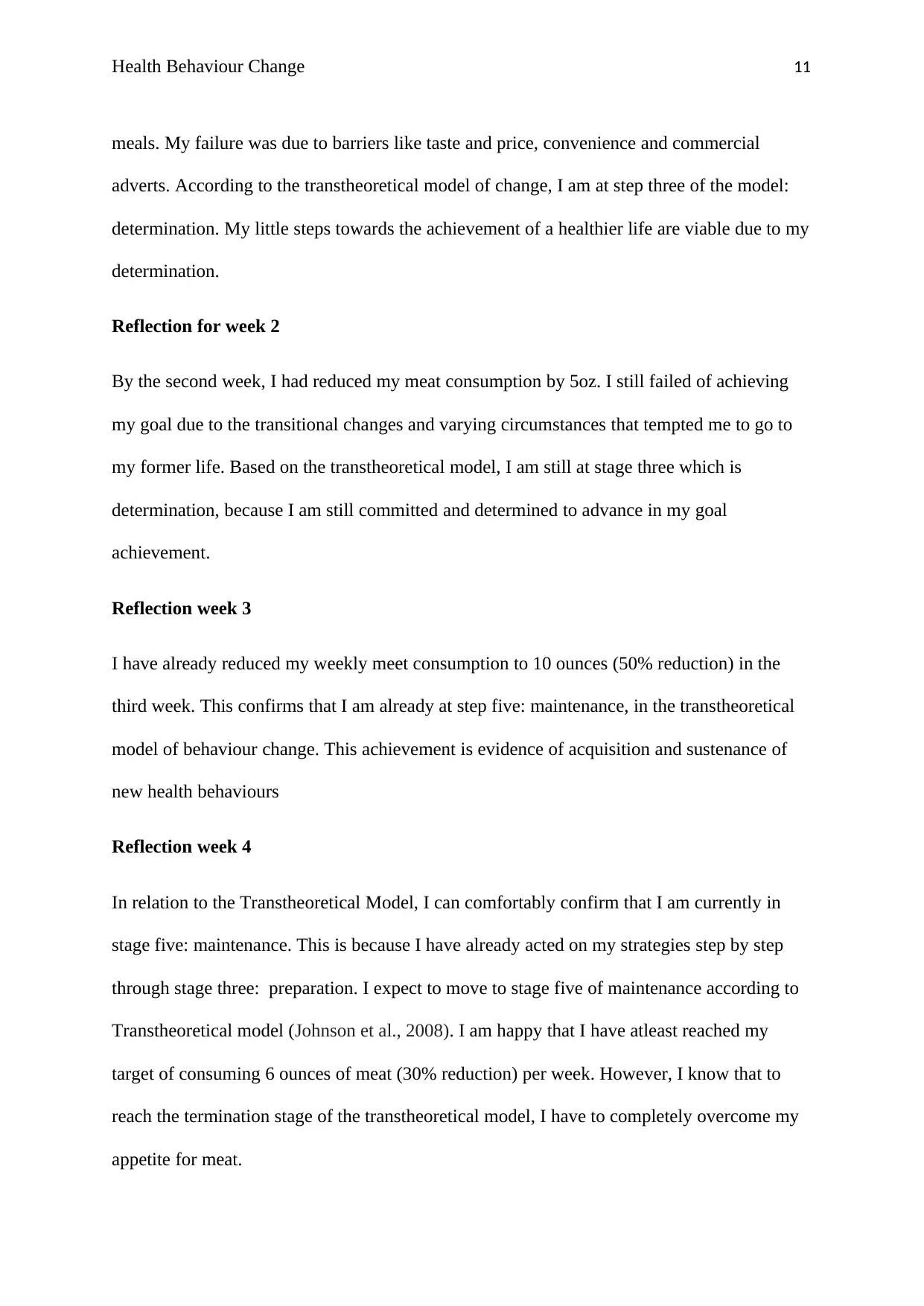
Health Behaviour Change 11
meals. My failure was due to barriers like taste and price, convenience and commercial
adverts. According to the transtheoretical model of change, I am at step three of the model:
determination. My little steps towards the achievement of a healthier life are viable due to my
determination.
Reflection for week 2
By the second week, I had reduced my meat consumption by 5oz. I still failed of achieving
my goal due to the transitional changes and varying circumstances that tempted me to go to
my former life. Based on the transtheoretical model, I am still at stage three which is
determination, because I am still committed and determined to advance in my goal
achievement.
Reflection week 3
I have already reduced my weekly meet consumption to 10 ounces (50% reduction) in the
third week. This confirms that I am already at step five: maintenance, in the transtheoretical
model of behaviour change. This achievement is evidence of acquisition and sustenance of
new health behaviours
Reflection week 4
In relation to the Transtheoretical Model, I can comfortably confirm that I am currently in
stage five: maintenance. This is because I have already acted on my strategies step by step
through stage three: preparation. I expect to move to stage five of maintenance according to
Transtheoretical model (Johnson et al., 2008). I am happy that I have atleast reached my
target of consuming 6 ounces of meat (30% reduction) per week. However, I know that to
reach the termination stage of the transtheoretical model, I have to completely overcome my
appetite for meat.
meals. My failure was due to barriers like taste and price, convenience and commercial
adverts. According to the transtheoretical model of change, I am at step three of the model:
determination. My little steps towards the achievement of a healthier life are viable due to my
determination.
Reflection for week 2
By the second week, I had reduced my meat consumption by 5oz. I still failed of achieving
my goal due to the transitional changes and varying circumstances that tempted me to go to
my former life. Based on the transtheoretical model, I am still at stage three which is
determination, because I am still committed and determined to advance in my goal
achievement.
Reflection week 3
I have already reduced my weekly meet consumption to 10 ounces (50% reduction) in the
third week. This confirms that I am already at step five: maintenance, in the transtheoretical
model of behaviour change. This achievement is evidence of acquisition and sustenance of
new health behaviours
Reflection week 4
In relation to the Transtheoretical Model, I can comfortably confirm that I am currently in
stage five: maintenance. This is because I have already acted on my strategies step by step
through stage three: preparation. I expect to move to stage five of maintenance according to
Transtheoretical model (Johnson et al., 2008). I am happy that I have atleast reached my
target of consuming 6 ounces of meat (30% reduction) per week. However, I know that to
reach the termination stage of the transtheoretical model, I have to completely overcome my
appetite for meat.
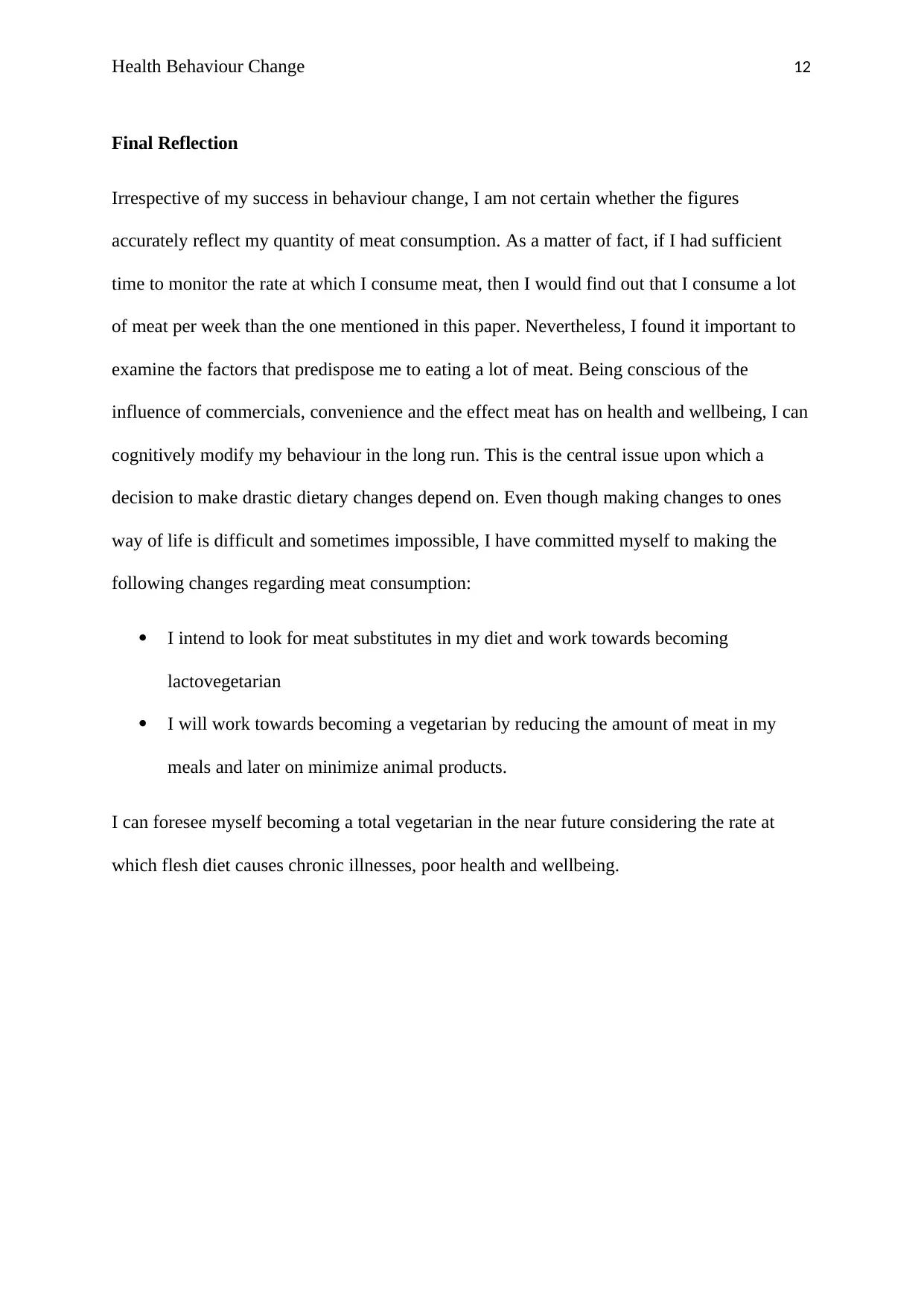
Health Behaviour Change 12
Final Reflection
Irrespective of my success in behaviour change, I am not certain whether the figures
accurately reflect my quantity of meat consumption. As a matter of fact, if I had sufficient
time to monitor the rate at which I consume meat, then I would find out that I consume a lot
of meat per week than the one mentioned in this paper. Nevertheless, I found it important to
examine the factors that predispose me to eating a lot of meat. Being conscious of the
influence of commercials, convenience and the effect meat has on health and wellbeing, I can
cognitively modify my behaviour in the long run. This is the central issue upon which a
decision to make drastic dietary changes depend on. Even though making changes to ones
way of life is difficult and sometimes impossible, I have committed myself to making the
following changes regarding meat consumption:
I intend to look for meat substitutes in my diet and work towards becoming
lactovegetarian
I will work towards becoming a vegetarian by reducing the amount of meat in my
meals and later on minimize animal products.
I can foresee myself becoming a total vegetarian in the near future considering the rate at
which flesh diet causes chronic illnesses, poor health and wellbeing.
Final Reflection
Irrespective of my success in behaviour change, I am not certain whether the figures
accurately reflect my quantity of meat consumption. As a matter of fact, if I had sufficient
time to monitor the rate at which I consume meat, then I would find out that I consume a lot
of meat per week than the one mentioned in this paper. Nevertheless, I found it important to
examine the factors that predispose me to eating a lot of meat. Being conscious of the
influence of commercials, convenience and the effect meat has on health and wellbeing, I can
cognitively modify my behaviour in the long run. This is the central issue upon which a
decision to make drastic dietary changes depend on. Even though making changes to ones
way of life is difficult and sometimes impossible, I have committed myself to making the
following changes regarding meat consumption:
I intend to look for meat substitutes in my diet and work towards becoming
lactovegetarian
I will work towards becoming a vegetarian by reducing the amount of meat in my
meals and later on minimize animal products.
I can foresee myself becoming a total vegetarian in the near future considering the rate at
which flesh diet causes chronic illnesses, poor health and wellbeing.
⊘ This is a preview!⊘
Do you want full access?
Subscribe today to unlock all pages.

Trusted by 1+ million students worldwide
1 out of 16
Related Documents
Your All-in-One AI-Powered Toolkit for Academic Success.
+13062052269
info@desklib.com
Available 24*7 on WhatsApp / Email
![[object Object]](/_next/static/media/star-bottom.7253800d.svg)
Unlock your academic potential
Copyright © 2020–2025 A2Z Services. All Rights Reserved. Developed and managed by ZUCOL.





